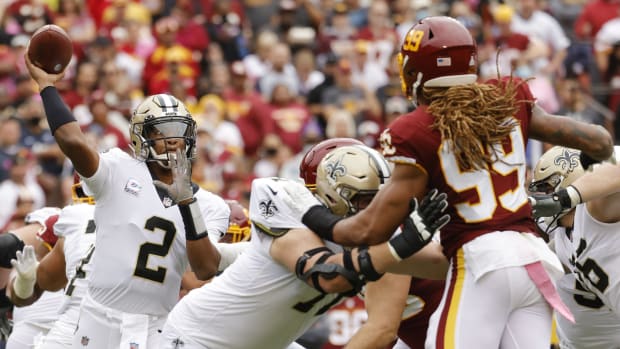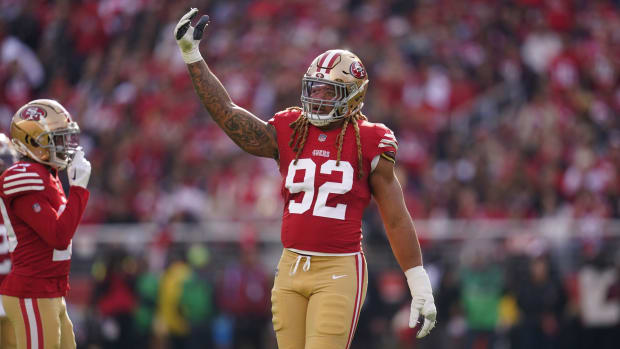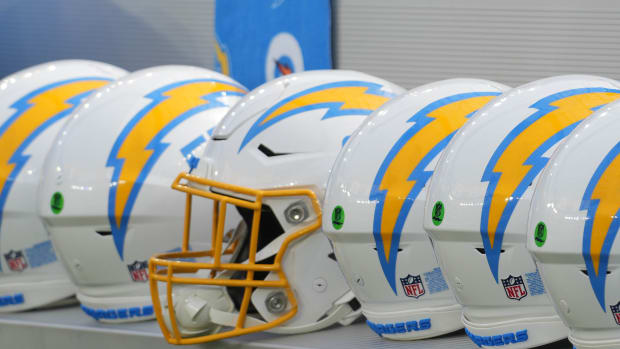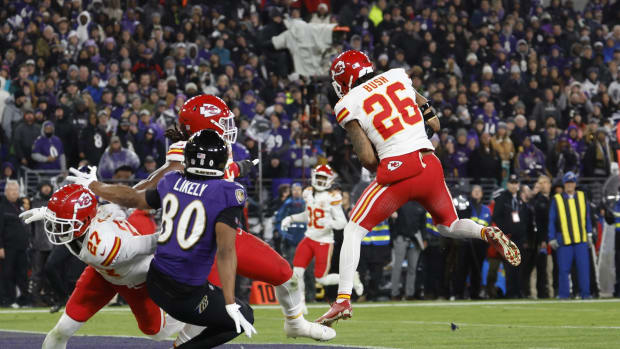Is the Hall of Fame Process Broken?
According to one voter, Michael Strahan had more support among the experts he polled during the 2013 process, but in the room the argument for Warren Sapp won over the voters. Strahan is among the final 15 again this year. (Maddie Meyer/Getty Images)
NEW YORK CITY — The 44 pro football writers gathered in New Orleans last year to consider, among other things, whether Warren Sapp should be a first-ballot Hall of Famer. His presenter, Ira Kaufman of TheTampa Tribune, knew what he was up against in making the case for the hometown defensive tackle.
“Warren Sapp is an a------,” he began, according to several people in the room, “and he treated me like s--- sometimes, but I’m here to say he should be in the Hall of Fame.”
It was blunt and honest, and maybe it worked. Sapp went in, and former Giants defensive end Michael Strahan did not, stirring up a conflict between the two retired defensive linemen that bubbled out into the open this week. On this eve of the 2014 selection meeting, we pose four questions raised in the aftermath of the 2013 vote, questions that go to the heart of whether the current selection process is the right way to determine who gets into the Hall of Fame, or whether changes need to be made. [Editor’s note: Peter King, editor-in-chief of The MMQB, is a Hall of Fame voter but did not participate in this story, to avoid conflict-of-interest issues.]
Should the nominees be presented?
Every year, a long list of nominees is whittled down to a small group, which is then decided upon during the Saturday before the Super Bowl. This year there are 17 finalists (including two Senior Committee nominees, Ray Guy and Claude Humphrey), with four to seven open spots, and each candidate must receive at least 80 percent approval from the selection committee—a group of 46 (up from 44 last year) established NFL writers. (There is one voter representing each of the 32 teams, and 14 at-large voters.) Character is not supposed to be a concern, simply on-field play. During the Saturday session, which can last up to eight hours, each candidate’s case is presented by one of the selection committee members. Often, the presenter is the writer from the NFL city where the player spent most of his career.
In that room, some believe the presentation can make the difference between a first-ballot Hall-of-Famer and a guy who has to wait.
Says second-year at-large voter Jason Cole: “In the battle between Warren Sapp and Michael Strahan, Ira Kaufman made the difference.”
Cole, who learned of his inclusion on the committee several months before the 2013 vote took place, did his homework on the candidates. He asked nearly 60 former players, current coaches and personnel men to objectively evaluate Sapp’s worthiness versus Strahan’s.
“More people said Strahan,” Cole says.
The disparity between the football community’s assessment of each player and the result of the committee jibes with former NFL exec Gil Brandt’s view on the qualifications of voters.
“There are certain writers who really do a good job. They call people and get the info necessary to make a decision,” Brandt says. “But most of these guys on here have never seen these players closely enough. All of a sudden the writer who’s the best orator sways things. It’s unfair.”
The NFL plans to film and air the presenters in 2014, allowing cameras in the room for the first time. Writers originally bristled at the prospect of airing any portion of the meeting publicly, but they have largely accepted the intrusion so long as it is confined to the presentations and not the ensuing discussion.
What would an airing of those discussions reveal? Ex-players would love to know.
“I can’t knock the process, but I do want to know the criteria,” says former NFL linebacker Willie McGinest, a first-year eligible nominee this year who did not make the list of 25 semifinalists in November. “If it’s play alone, if it’s a sack thing, a behavioral thing, how you acted with the media, if it’s a Super Bowl thing… I’m not really sure.”
Are voters using the right criteria?
The 2014 Finalists
Morten Andersen
Jerome Bettis
Derrick Brooks
Tim Brown
Edward DeBartolo
Tony Dungy
Kevin Greene
Charles Haley
Marvin Harrison
Walter Jones
John Lynch
Andre Reed
Will Shields
Michael Strahan
Aeneas Williams
Ray Guy (senior)
Claude Humphrey (senior)
For a list of the 46 voters, go HERE.
How are the nominees narrowed down and eventually enshrined? Many voters who don’t do the opinion-gathering routine go by the “smell test,” says
USA Today
’s Jarrett Bell, the 16th-year at-large voter who says he does ample research. The format, he says, is conducive to loosely defined criteria. The room is big enough that all viewpoints will be represented, yet small enough that a discussion take place and the vote doesn’t turn into a popularity contest.
“This process I like because you discuss it,” says selection-committee member John Clayton of ESPN. “When you get to 15, there’s a very good chance a person gets in eventually down the road. You’re not saying someone is not a Hall of Famer.”
Cole consults with Bill Belichick occasionally on nominees, and the Patriots coach has the same question as McGinest.
“Belichick asks me what’s the criteria, and I said I don’t know,” Cole says. “We’re making it up as we go along.”
Should players of the same position be compared to one another, or to the finalist group at large? Which counts more: production or wins? How do you compare a Super Bowl-winning running back to a founder of NFL Films? Each of the writers who spoke with The MMQB agreed that the slots for players and non-players ought to be separate. Team owners Ed DeBartolo, Jr. and Art Modell and coach Bill Parcells were among the preliminary candidates in 2013, but many voters refuse to use a spot on a contributor over a player.
“I believe that one of those guys should go in,” Cole says. (Parcells made it in last year; DeBartolo is among the final 15 this year.) “But I wasn’t going to vote for one of them because I think players should go first.”
“The players are the lifeblood of the league,” says voter Bob Glauber of Newsday.
Occasionally, it boils down to something far simpler than playing status or championships: You vote for my guy, and I’ll vote for yours.
Are the writers forthright enough during the debate?
“I’ve been in it for three years, and it happened one time,” says Glauber of such deal-making. “I was mortified. I didn’t like it. It was very uncomfortable. But I think that stuff is going by the wayside. There was quite a bit of it from what I heard 10 to 15 years ago.”
Those on the outside aren’t so assured. “There are cliques,” says Brandt, “even though they won’t admit it.”
If there are, it would be nearly impossible to smoke them out. The balloting is secret, and it’s perfectly within a voter’s right to abstain from the conversation surrounding a player nominee and then decline to vote for him. Bell has a name for such covert voters: “silent assassins.”
“No one objects,” he says, “and you’re thinking the guy’s getting in and it’s all good, and all of a sudden he doesn’t have the votes. Sometimes I think there is a bloc of voters that swings it. But if that exists, I haven’t been invited.”
Allegations of blocs and cliques are most often raised by players searching for answers as to why they or their teammates have failed to be elected. Most players waiting for first-time nominations are reticent about suggesting impropriety on the part of the writers or that the writers themselves are not worthy, for fear that no Ira Kaufman will step up to perform their very own version of the Sapp Persuasion. But most players aren’t Randy Moss.
Should writers vote on the Hall of Fame?
Randy Moss, no friend to the media during his playing days, thinks players, rather than writers, are best qualified to judge who’s Hall-worthy. (John Biever/Sports Illustrated)
“If you didn’t play the game and you don’t know what we go through as players, you shouldn’t talk about it,” says Moss, the former receiver now working for FOX and a player considered a potential first-ballot enshrinee. “When these writers are responsible for voting you to the Hall of Fame, it isn’t fair. I think it should be ex-players and coaches, because they know the game of football.
“Just because you have a pen and a pad doesn’t mean you know what you’re talking about. I’m not discrediting a person who’s been covering a team for 30 years, but we need to understand that football is played between the lines.”
It’s a popular sentiment among players. Who knows a wide receiver better: the writer who covered him in the paper or online, or the corner who covered him on the field? As Clayton points out, football doesn’t support analytical research the way baseball, hockey and basketball do. We can judge quarterbacks based on stats to an extent, but what about guards? Players and coaches may be best qualified to judge, but they aren’t necessarily completely objective and free of bias either, as Sapp demonstrated this week when he said Michael Strahan didn’t belong in the Hall.
“Football is a competitive sport,” Clayton says. “Some people like the people they work with, some people don’t. Strahan isn’t deserving of the Hall of Fame? What are you really saying? You don’t like him? That hurts the cause. You’re showing an agenda.”
Say what you will about Sapp and the Hall he belongs to, but don’t say Ira didn’t warn you.
For The MMQB’s complete Super Bowl coverage, go to our Super Bowl hub.








































